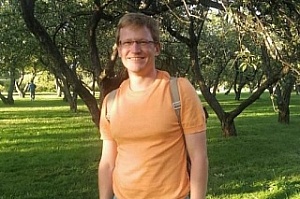Dmitry Karlovets, а TSU physicist, mathematically proved that twisted particles retain an unusual quantum state and exhibit wave properties when reaching high speeds, while ordinary particles do not exhibit wave properties. These calculations, in an experiment at a modern collider, could lead to a new trend at the intersection of particle physics, accelerator physics, and quantum optics. An article about the study was published in the New Journal of Physics.
Electrons, neutrons, photons, and other elementary particles can, under some conditions, exhibit the properties of waves, and under others, can exhibit the properties of particles. This phenomenon is called wave-particle duality. Under normal conditions, an electron exhibits wave properties only at low energies. So as a particle it can be considered only at high energies. However, relatively recently, physicists have learned to twist electrons and neutrons, from which their characteristics change dramatically.
In the state of a wave, when an electron moves, its charge is uniformly smeared over a certain area, which is called the wavefront. Twisted elementary particles are those in which the wavefront is similar to the screw of a meat grinder - that is, it rotates around the axis of the direction of their movement. Until now, scientists have been able to create such unusual quantum states of particles only with electron microscopes at moderate energies. Nevertheless, even this made it possible to significantly improve the quality of the analysis of the magnetic properties of nanomaterials and opened up new possibilities for atomic spectroscopy and electron microscopy with a resolution of tenths of nanometers.
Dmitry Karlovets, Doctor of Physical and Mathematical Sciences, senior researcher at the TSU Laboratory of Theoretical and Mathematical Physics, theoretically proved the fundamental possibility of creating twisted particles at high energies using accelerators. He described the processes occurring with them using computer modeling and methods of mathematical physics.
- The technical difficulty is that these particles must first be twisted and then accelerated to high energies. The question arose whether their unusual quantum state is preserved under such acceleration.? It turned out that if the beam is accelerated and focused by standard methods that are used in accelerators, the twisted state turns out to be stable, and the particles do not lose their wave properties, - said Dmitry Karlovets.
If these ideas are realized in an experiment, it will help to create beams of twisted particles with enormous energy: hundreds and even thousands of times more than now, and not only light electrons, but also heavy protons, ions, and so on. This could give physicists new tools for analyzing the structure of compound particles - hadrons, atoms, and ions. In particular, twisted electrons with high energies would help to study the spin of a proton - one of the modern mysteries of high-energy physics, since the large orbital moment of such an electron will enhance the interaction with the spin of the proton and the angular moment of its constituent particles.
- Now, at all accelerators, both small ones of applied value and large ones, including the Large Hadron Collider, particles in certain quantum states are not created for experiments. The beams are formed, focused, accelerated, and then collided with a target or with each other, but they are not specially prepared. My task is to convince the experimenters that the practical application of the proposed scheme can give interesting and very promising results, concluded Dmitry Karlovets.
Beams of particles in unusual quantum states can provide new tools for analyzing the properties and structure of matter and the properties of the particles themselves. Until now, experimenters have created classical beams of particles of various shapes, where each particle flew with its energy and in a certain direction. Quantum beams consist of particles, where each particle seems to fly in different directions at the same time. This property makes it possible to create new sources of pairs of so-called entangled particles, which is important both for the development of quantum optical communication technologies and quantum computers.

